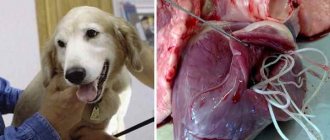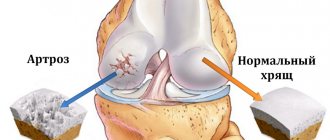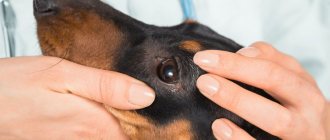What kind of helminths are these?
Most owners mistakenly assume that lungworms are some kind of “exotic” disease that is practically never found in our latitudes, but in fact, everything is quite prosaic if you understand the development cycle of roundworms.
The larva of a worm that has just hatched from an egg is so small that it has no difficulty drilling through the walls of blood vessels. It is through the bloodstream that the worm enters the animal’s pulmonary alveoli, where it stops and continues to grow.
Reference! The development cycle of lungworm lasts from two weeks to several months.
Symptoms
The general symptoms of infection with lungworms are the same as with other infestations, namely:
- general weakness;
- loss of appetite;
- deterioration of the condition of the skin and coat;
- sunken eyes.
Penetrating into the lungs, worms cause such symptoms in dogs as:
Signs of respiratory diseases of varying severity are added to the general symptoms.
Note! If there is a high degree of roundworm infection, the dog may develop bronchitis or pneumonia.
Treatment
Treatment includes all the same medications as for ordinary roundworms, but there are some nuances.
The fact is that lungworms cause inflammatory processes in the lungs and bronchi, and if the animal is already exhausted by the disease, or does not have strong immunity due to age (a puppy or an elderly dog), this can lead to severe pneumonia.
To eliminate these consequences, veterinarians prescribe broad-spectrum antibiotics.
In particularly advanced cases, when the animal is suffering from a severe cough, expectorants are also prescribed to thin the mucus and facilitate its exit from the lungs. You must purchase products strictly from a veterinary pharmacy. Medicines intended for humans will simply be ineffective.
Drugs
In order for a dog to recover quickly, it is necessary to select a medicine in accordance with its physiological, breed and age characteristics. Therefore, before purchasing an advertised drug, you need to consult a veterinarian. Most often, experts prescribe the following remedies:
Sometimes several drugs are used alternately to increase efficiency.
At home
In most cases, treatment takes place at home, but the course of treatment and the choice of medications should be fully supervised by a veterinarian. This is the only way you can be sure of its effectiveness. If the animal’s condition is critical, it is placed in a hospital under professional supervision.
Traditional methods
There are many traditional medicine recipes aimed at treating helminthic infestations. It is worth considering that their effectiveness has not been proven by medical tests. Therefore, by trying to cure your dog with grass, giving up “harmful chemicals,” you can only delay its recovery or even sign its death sentence.
Prevention
It is impossible to protect your pet 100% from infection with worms, but you can still reduce the likelihood by observing the following preventive measures:
- If your dog relieves itself on the street, make sure that it does not lick other animals and especially does not eat feces.
- Walk away from landfills, yard dogs and contaminated areas.
- When returning from the street, always wash your dirty shoes.
- Give your dog anthelmintic medications two weeks before mating.
- Do not neglect routine examinations at the veterinarian and the mandatory use of antiparasitic medications.
Prevention of helminthiases
Prevention is necessary, since getting rid of parasites is accompanied by severe suffering, and it is very easy to pick them up on the street.
Therefore, it is necessary to follow certain rules so that the dog does not get sick:
- The main rule of prevention is annual scheduled deworming. It is she who gives the highest (but not 100%) guarantee that the pet will not become infected with helminths.
- Since the main source of infection is small wild animals (frogs, rats, etc.), attempts by the dog to hunt them should be prevented.
- It is also advisable to avoid playing with picked up sticks and other dirty objects.
- In general, it is necessary that your pet wear a muzzle when outside, since he can become infected with helminths by eating herbs (and dogs sometimes do this), or drinking from a natural source.
- Before mating, the expectant mother must be dewormed.
- Puppies must be regularly given anthelmintic drugs at 2-3 months, then at six months and a year.
On the relationship between intestinal nematodes and lung diseases
Let us immediately emphasize that in nature there are types of helminths that parasitize directly in the lungs. But they don't occur very often. As a rule, “pulmonary” refers to worms, the larvae of which need to mature for some time in the bronchi and alveoli of the animal. And there are a lot of them. In fact, these are the majority of parasitic nematodes whose adults live in the intestines.
Development cycle
So how do intestinal helminths end up in the respiratory system? Here's what happens. When a dog swallows food or water contaminated with parasite eggs, the eggs enter his digestive tract. After some time, digestive enzymes eat away the shell of the eggs, and the larvae are free (digestive secretions do not affect them). It would be logical to assume that they remain in the gastrointestinal tract and gradually grow to adulthood, but this is not the case.
Specific types of lung parasites
There is a species of parasitic nematode in nature called angiostrongylus vasorum . They cause Angiostrongylosis. This disease is severe and is characterized by a high probability of developing dangerous complications. Studies have shown that parasites of this species, when introduced into the body of a susceptible animal, almost always lead to the development of pneumonia, and in some cases, congestive heart failure and pulmonary edema .
However, deaths are quite rare, but this is largely due to the rather modest prevalence of the disease itself. There is a certain age predisposition : the younger the dog, the higher its chances of getting sick. In addition, for some as yet unknown reasons, all types of spaniels and bulldogs are more often infected.
Intermediate hosts and transmission routes
Natural reservoir hosts include almost all types of land mollusks , including slugs and snails. Because of this, dogs rarely get sick under normal conditions: the likelihood that your dog will gobble up slugs with appetite is extremely small.
But! This was believed to be the case only until recently. Today it is known that there is a high probability of infection through saliva and feces. Given the tendency of dogs to mutual sniffing and licking, as well as coprophagia, the actual prevalence of the disease may be much higher. Moreover, researchers suggest that parasite larvae can also be found in the body of frogs , and dogs eat them much more often.
Pathogenesis
It is necessary, however, to take into account that the dog will only get sick if it swallows a snail, frog, or waste products of other animals containing third-stage larvae. If the larvae are “immature”, they will not be able to survive in your pet’s body.
First, the larvae penetrate the blood , gnawing through the intestinal wall to the vessels, then, together with the general blood flow, they are sent to the lymph nodes. There they ripen for several days, and then again enter the bloodstream, reaching the lungs (and not only). Thus, worms are often found in the cavities of the heart and large blood vessels (which is partly related to angiostrongylus vasorum with heartworms).
So, the parasite did get into the lungs. There it begins to actively feed and grow, subsequently the worms (and they are dioecious) grow to a sexually mature state. Moreover, the most unpleasant thing is that in advanced forms of the disease, the dog’s lungs resemble bags, where half of the alveoli are filled to capacity with eggs and larvae of parasites.
In such cases, the larvae often gnaw through the walls of the alveoli, enter the vessels and are sent to the lymph nodes... the circle is closed, the disease enters the chronic phase (with this course, the larvae do not need to make their way through the aggressive environment of the intestine, and therefore they do not need to ripen). Considering that the pet may simply have nothing to breathe, he begins to choke and cough almost non-stop.
How do larvae get into the external environment? Just. Animals cough, the larvae are coughed up with sputum, swallowed, and come out with feces. There they are eaten by snails and, possibly, frogs (although how the larvae actually get into their body is a question), after which the parasites begin to mature in the body of the intermediate host.
Symptoms
Unfortunately, there are many cases where infection is asymptomatic for the time being. Only when the dog’s body runs out of all reserves does the disease “unfold.” But still this does not happen so often. As a rule, soon after the parasites penetrate his lungs, the dog begins to cough for no reason and constantly, and tries to breathe strainingly and wheezing during attacks. Other characteristic symptoms include:
- Vomiting movements. It seems that the dog is about to vomit, and this happens several times during the day.
- Vomit. Due to constant irritation of the throat, it can become chronic.
- Loss of appetite : worms in a dog’s lungs do not contribute to the animal’s well-being.
- Weight loss.
- General malaise.
Symptoms of known species
There are several types of these parasites, and each of them manifests itself in its own way. Let's look at the groups of worms and the symptoms that indicate the presence of infection.
The symptoms of this type of parasite are similar to the symptoms of respiratory diseases, so the doctor does not prescribe the correct treatment right away. Here's how a heartworm infection manifests itself:
- 3-3.5 months after the parasites enter the body, the animal begins to cough (at this time the worms enter the lungs and disrupt the breathing process, and the discharge of the worms leads to the development of inflammation);
- after the cough appears, the dog becomes inactive and lethargic, appetite disappears, breathing becomes heavy, wheezing is heard;
- animals are vomiting, and there is blood in the vomit;
- worm discharge leads to the destruction of red blood cells, which leads to the development of liver and kidney failure;
- at a late stage of the disease, the animal loses the ability to move independently;
- the chest greatly increases in size during breathing;
- at the last stage, the worms penetrate the blood vessels and heart valves, thereby provoking the development of arrhythmia.
The initial symptoms of lungworms are not specific: the animal becomes lethargic, eats poorly, the coat becomes brittle and dull. As the disease progresses, signs of severe disruption of the gastrointestinal tract (gastrointestinal tract) are observed: blood in the feces, rapid weight loss.
The animal develops anemia (anemia), the eyes become sunken. Worm larvae penetrate the lungs, which leads to the development of shortness of breath and cough. With severe infection, pneumonia or bronchitis develops.
In addition to heartworms and lungworms, there are other types:
- Intestinal. They manifest themselves as follows: the dog refuses food, the stomach becomes noticeably swollen, and loose stools are observed.
- Hepatic. Specific symptoms of infection with these worms: dysfunction of the gallbladder, pancreas and liver. Animals do not eat, the stomach becomes painful.
Diagnostics
Making an accurate diagnosis for this disease is quite difficult. Considering that the clinical signs are quite vague, experienced veterinarians can only rarely suspect pathology. Most often, owners and doctors believe for a long time that the dog suffers from “ordinary” lung diseases. However, if the area in which the pet lives is initially unfavorable for angiostrongylosis , the diagnosis can be made based only on clinical manifestations.
If your veterinarian truly suspects that your animal has lungworms, he will take stool samples and, preferably, sputum samples. It should be taken into account that at least three samples of feces should be examined, since some of the larvae inevitably die when exposed to harsh conditions of the gastrointestinal tract, and their number is not always significant (and therefore it is much more reliable to study pulmonary sputum).
It is believed that the Berman test (unfortunately, in our country there are few places where it can be performed). The scientific literature says that the result can be obtained after eight hours, but in practice the situation is that in moderately and heavily infected dogs everything is visible after half an hour.
X-ray and ultrasound of the chest and abdominal cavities are also necessary , since it is necessary to find out whether there are foci of larval development in them. A blood test may show the presence of anemia. In addition, bronchoscopy is highly recommended, since using this method it is possible to study the condition of the lungs and bronchi with high accuracy.
Treatment of lungworms in dogs
Treatment will depend on the stage of the infection. Unfortunately, in advanced cases the prognosis is unfavorable, since the animal will almost certainly have internal organs damaged. Practice proves that the kidneys and pancreas are most often affected.
What drug can be used to reliably kill lungworms? The most common febendazole . Milbemax is indicated , but these tablets only suppress parasites, but do not kill. So you still have to give febendazole to your pet.
At the same time, the dog is given anti-inflammatory corticosteroids to relieve inflammation and antibiotics used to prevent secondary bacterial infections. To speed up the removal of parasites from the lungs, bronchodilators are used. Antihelminthic drugs are prescribed four times, the interval between administrations is a week. It is recommended to repeat the course in a month.
Any pet, regardless of whether it is on a street walk or leads an exclusively domestic lifestyle, in most cases is already infected with helminths. These parasitic worms are present almost everywhere: in puddles, ditches, on grass, in the ground, in fish and meat products.
Many dog owners, without knowing it, are carriers of parasites. Upon returning home from the street, most people do not try to wash their street shoes, but, as a rule, leave them in the hallway. Dogs love to chew, sniff or lick their owner’s shoes, and along with the dirt, helminth eggs also enter the pet’s body.
Worms in dogs are a very common problem that needs to be addressed as quickly as possible. By parasitizing the animal's body, helminths not only suck out all the beneficial substances from the dog's body, but also cause severe intoxication, often ending in the death of the dog.
Deworming is the most effective way to combat parasites, protecting not only the animal, but also its owners from worms. Not a single veterinarian will allow an animal to participate in exhibitions, mating, or undertake to vaccinate a four-legged friend if the dog is not treated for worms before vaccination.
Prevention of cough in dogs
If a dog vomits foam and sneezes, what should the breeder do? Treatment of cough in dogs should be carried out strictly based on the results of an examination by a specialist who will first identify the cause. As for the breeder, he must take preventive measures on time; this is the only way to reduce the risk of disease.
What does prevention mean:
- regular check-ups with a doctor;
- pet vaccination;
- implementation of parasitic prevention;
- providing the animal with all the necessary vitamins;
- providing the dog with a quality diet and living conditions;
- Always monitor your dog for changes in behavior and activity.
You can find out the answer to this question from the video (the author of the video is Russian Toy Michelle - care, sewing clothes, shopping).
Types of worms in dogs
Experts know many varieties of worms that parasitize inside the body of pets.
Some worms in dogs live and multiply in the digestive tract, causing diseases of the internal organs and causing severe exhaustion or chronic diarrhea in the animal. Some types of helminths prefer to live in the organs of the cardiovascular system and lungs, leading to disruption of the heart, the development of pneumonia, and a painful cough. Most worms that infect the body of pets pose a real danger to human life, so it is important to know what worms look like in dogs.
There are 3 groups of parasitic worms:
- Nematodes or roundworms.
- Cestodes or tape parasites.
- Flukes , known as flatworms.
More than 80 varieties of roundworms are found in nature, but not all parasites can live in the body of a pet.
Nematodes have a round (spherical) body shape, which is why they got their name.
The most common helminthic infestations caused by roundworms are:
- Dirofilariasis . The causative agent of the disease is a white worm, the females of which reach a length of 15 cm, and the males - no more than 5 cm. Mosquitoes serve as intermediate hosts of the helminth. The larvae (microfilariae) of the parasite enter the dog’s body through the bite of a blood-sucking insect, then, through the bloodstream, rush to the main muscle - the heart. Living and actively reproducing in the organ, worms lead to disruption of its functioning. Gradually, all the cavities of the main muscle can be filled with helminths, which is why the animal always dies. Dirofilariasis is a very severe infestation, since in the early stages of the development of the disease all the signs are similar to heart failure, and an incorrect diagnosis can cost the dog his life.
- Toxocariasis . The disease is caused by 20 cm helminths with a light yellow body color. After penetrating the dog’s body, the worm larvae enter the bloodstream and spread to the vital organs of the animal (first to the liver, then to the heart and lungs).
- Ascariasis (toxascariasis). Parasitic worms have a body length of about 8 cm and are colored light yellow. Roundworms prefer to live in the intestines, gall bladder, liver and esophagus of dogs. Infection with ascariasis occurs mainly in places where dogs gather in large numbers (walking areas). Failure to treat the infestation soon leads to the death of the animal.
Cestodes are considered the largest parasitic worms. People call tapeworms tapeworms, since in appearance their body looks like a chain consisting of links.
The length of some adult worms reaches more than 10 meters. The parasite is equipped with a scolex (oral apparatus) and hooks, thanks to which it literally pierces the organs of its victim. The body of the tapeworm consists of many segments (segments). In each of the segments, the eggs of the parasite mature.
Together with feces, the segments leave the dog’s body, enter the external environment, and dry out under the influence of oxygen, leaving behind a large number of eggs.
Dogs become infected only through intermediate hosts (river fish, amphibians, blood-sucking parasites, rodents). When eating an infected animal, insect or fish, the dog swallows the parasite larva along with the food.
Once in the gastrointestinal tract, the larva is securely attached to the intestinal walls, actively feeds, grows, and after a short period of time reaches maturity.
Tapeworms in dogs are dangerous because when they accumulate massively in the intestines, they form peculiar balls, leading to complete blockage and then rupture of the organ.
Cough in animals due to worms
Not only people, but also pets are faced with parasites. Worms can live in the body of cats and cows. The dog is also not protected from the development of parasitic diseases. Upon contact with them, a person becomes infected.
- What does coughing in pets mean?
- What kind of cough may indicate the presence of worms?
- How does infection occur?
- What helminths live in the lungs of animals?
- Possible complications
- Establishing diagnosis
- Treatment measures
- Prevention measures
You can see what a cough in a cat or cow looks like or how a dog coughs in the video presented on the website.
What does coughing in pets mean?
Have you noticed that your cat or dog has a cough? Is your dog suffering from asthma attacks? Cows can also suffer from this symptom. What causes it?
Cough is a physiological reflex that occurs when a signal is transmitted from certain receptors to the center of the brain. This property is not unique to humans, but also occurs in dogs and even cats. Many cattle breeders note that cows can also cough. This symptomatology does not develop independently, but is a manifestation of some pathology. Most often this occurs when the functioning of the respiratory system is impaired.
What kind of cough may indicate the presence of worms?
Depending on the degree of damage and the cause of development in a cat, cow or dog, the cough can be different: prolonged, wet or dry, strong, loud. Symptoms may appear at different times of the day. The listed criteria are very important. Without them, it is impossible to accurately determine the cause.
In addition to a pronounced cough, cows and cats also experience a number of additional symptoms due to helminthic infestation. The dog may also suffer from a number of manifestations of helminthic infestations. First of all, the body weight of the animal decreases. A cat or cow may become depressed. The dog may also suffer from weakness. Pets lose their appetite and experience dyspeptic symptoms (constipation, diarrhea). A cow or cat usually develops anemia. The dog also suffers from exhaustion of the body.
The progression of helminthic infestations leads to the appearance of external signs in cattle, cats and dogs, which include pallor of the mucous membranes and loss of tufts of hair. The coat loses its shine. Cows and cats often show no symptoms of parasitic diseases. Cattle may experience a decrease in milk production. Miscarriages in cats are also possible. The dog may suffer from the appearance of deposits, which usually occur after childbirth.
How does infection occur?
Helminths can enter an animal's body in various ways. Dogs and cats can ingest them in street dust. This can happen in the yard or in the apartment. Worm eggs enter homes on a person's shoes. A cow can drink water from a pond in which helminths live. In the intestine, larvae emerge from the swallowed eggs, which quickly become sexually mature individuals and begin to multiply quickly.
From the intestines, small individuals of the larval form leak into the bloodstream, from where they are carried into the lungs. Parasites that end up in the trachea and bronchi cause mucus to accumulate inside the respiratory organs. It is this that causes difficulty in breathing and shortness of breath. Coughing leads to the release of helminth eggs. They remain in the animal's mouth, are swallowed and again penetrate into the intestinal area. The period of their development into an adult takes no more than 8 weeks.
That is why, by promptly paying attention to cough, you can prevent damage to the internal organs of cats, dogs and cattle.
What helminths live in the lungs of animals?
There are several types of worms that live in the respiratory area of domestic animals. Among the most frequently encountered parasites are Aelurostrongylus abstrusus and Capillaria aerophila. They are most often diagnosed in cats. The dog can also become infected. Worms, as a rule, reach a size of no more than 1 cm. They need intermediate hosts for development. As a rule, these are slugs or snails. They enter the body of domestic animals through mollusks or through intermediate hosts: birds or mice.
Lungworms are found primarily in cats and dogs that roam outside unattended. Cows can become infected on pasture if there are poor quality watering places.
Possible complications
The level of harm caused by worms depends on the degree of lung damage, the stage of progression of the inflammatory process and the number of infective larvae. Minor pulmonary lesions may go unnoticed. In severe stages of infection, an increase in body temperature is often observed.
Important! Animals, like people, need timely treatment.
The presence of worms in the lungs causes damage to the respiratory system. The inflammatory reaction is fraught with the development of serious pathologies. Among the main complications are interstitial emphysema. In this case, there is an accumulation of small bubbles containing air in the area of the lung tissue. This causes the development of edema and secondary bacterial pneumonia.
The chronic form of helminthiasis in domestic animals and cattle leads to scarring of the lung tissue. This is fraught with lifelong chronic cough, which does not go away even after antiparasitic treatment.
Establishing diagnosis
To confirm the diagnosis, the veterinarian prescribes a set of necessary tests. First of all, it is necessary to take a stool test for the presence of worm eggs. This study allows you to accurately assess the stage of infection and the types of parasites in the animal’s body. In some cases, it is recommended to take a blood test. This diagnostic measure allows you to identify the presence of an inflammatory process.
Worms can be detected by microscopic examination of sputum produced when coughing. The most informative procedure is an x-ray examination, which allows you to visualize the condition of the lungs. With helminthic lesions, the presence of thickening of blood vessels and characteristic darkening is noted.
Treatment measures
The veterinarian prescribes treatment taking into account the type of animal and the stage of development of helminthic infestation:
- Cats. First of all, the specialist carries out antiparasitic treatment. The means for deworming in cats is selected individually. For the purpose of prevention, a course of treatment is prescribed at intervals of 3-6 months. It is mandatory to prescribe anti-inflammatory drugs that relieve inflammation and prevent the development of complications in the lung area in cats.
- Dogs. The treatment regimen and dosage of antiparasitic drugs are prescribed by a veterinarian. It is important to start therapy in a timely manner, which should include drugs that suppress the vital activity of parasites and drugs that remove waste products from the body.
- Cows. Treatment of fascioliasis is carried out under the strict supervision of a specialist. As a rule, medications are given to the entire herd without exception. Anthelmintic drugs are prescribed strictly individually. The doctor calculates the dosage depending on the body weight and condition of the cattle.
Prevention measures
To prevent infestation with worms, it is recommended to keep pets and cattle clean. Animals should be given only clean water and balanced food. The daily diet should contain carbohydrates, proteins and minerals in residual quantities.
Before starting to use anthelmintics, be sure to consult with your veterinarian. An incorrectly selected product or an incorrectly calculated dosage can cause great harm to the animal. Timely preventive measures eliminate the possibility of infection.
Ways of infection of dogs with worms
All dogs are susceptible to helminthiasis, regardless of age and breed. Sometimes it is difficult to understand that a dog has worms. In some cases, the infestation may remain asymptomatic for a long time. Small puppies and teenage dogs are more susceptible to helminthic diseases than their adult counterparts. The presence of worms in the body can be caused by different routes of parasite penetration:
- Hematogenous. Some parasites are transmitted to dogs through insect bites. Helminth larvae penetrate the animal’s bloodstream and then spread throughout the body.
- Oral. The eggs of parasitic worms enter the dog’s body through direct contact of the pet with sources of infection (feces of sick animals, food, soil, standing water).
- Intrauterine . A pregnant bitch is capable of transmitting helminths to her offspring. The most common disease transmitted from mother to fetus is toxocariasis.
Is it possible to get worms from a dog?
Humans and other pets can easily become infected with certain types of worms, such as echinococcosis, from dogs. Helminth eggs enter the body after communicating with the dog from unwashed hands, from under the nails. They can enter through the mucous membranes, for example, if a person rubs their nose or sneezes.
To avoid infection, you need to avoid kissing your pet, wash your hands with soap every time after communication, and limit its location in the apartment, not allowing it on your bed or at the table. In addition, frequent wet cleaning using disinfectants will help reduce the likelihood of infection.
Symptoms of worms in dogs
Any owner of a four-legged friend should know the signs of a helminthic infestation that has developed in a pet. Symptoms of worms in dogs are as follows:
- Dramatic weight loss. Parasitic worms suck out all the beneficial substances from the dog, as a result of which the animal’s body becomes exhausted.
- Frequent rumbling in the stomach, an increase in the volume of the abdominal cavity. Worms in dogs, such as roundworms, cause similar symptoms.
- Frequent vomiting. Occurs mainly when dogs are infected with tapeworms.
- Prolonged diarrhea. Indicates infection with whipworms or nematodes.
- Blood and mucus in feces. Happens when dogs are affected by hookworm.
- Skin rash, dullness and hair loss. It is considered a characteristic sign of roundworms.
- The presence in the animal's feces of white moving segments, similar to rice or cucumber grains. In this case, determining that a dog has worms (cestodes) is not difficult.
- Painful sensations and itching in the perineum. The animal constantly tries to ride on its butt and lick the anus. This behavior indicates characteristic signs of worms in a dog.
- Paleness of the mucous membranes of the eyes and mouth. The dog's loss of nutrients leads to the development of anemia.
In dogs of small breeds, helminthic infestations are more severe than in large dogs. Most decorative pets do not tolerate anthelmintic drugs well, so pets should be treated only under the strict supervision of a veterinarian.
Parasites living in the heart are quite difficult to identify. You can know that your dog has worms if you experience symptoms such as:
- increased breathing, attacks of shortness of breath;
- abdominal enlargement;
- painful cough;
- severe weakness of the body;
- sudden hair loss.
Heartworm is dangerous because all the symptoms of its presence appear only when the disease has become widespread and it is no longer possible to save the dog.
Why are helminths dangerous for dogs?
If left untreated, worms in dogs can lead to serious consequences over time, including:
- weakened immunity and retarded growth and development due to insufficient supply of nutrients to the animal’s body;
- mental exhaustion of the dog due to constant itching, pain, discomfort;
- the addition of infection against the background of a decrease in protective forces, the development of numerous diseases;
- serious intoxication of the pet’s body with toxic metabolic products of parasites, the development of allergic reactions.
Helminths lead to diseases of the liver, brain, heart, lungs and other organs. Ignoring the symptoms of worms in a dog is fraught with the development of jaundice, heart attack, epilepsy, intestinal obstruction, cerebral hemorrhage, loss of vision and other consequences, including death.
Important: according to statistics, more than 60% of domestic dogs are infested with helminths. At the same time, infected pets look clinically healthy, so owners do not always suspect that their beloved animal is sick.
Intestinal parasites in dogs
Treatment of helminthic infestations in dogs
Helminths in dogs are very dangerous and require immediate treatment for your four-legged pet. If you suspect a worm infection, you should contact a veterinarian.
Only a doctor can accurately determine the type of parasite and prescribe effective treatment that can remove worms from a dog. Self-administration of antihelminthic drugs can lead to severe poisoning and death of the pet.
Veterinarians advise using the following medications for helminths:
- Kanikquantel is an effective anthelmintic drug that provides gentle treatment. Produced by German manufacturers. It differs from many drugs in the absence of side effects and reasonable price. Has a wide spectrum of action.
- Prazitel - has a destructive effect on any helminths. Approved for therapy of puppies.
- Drontal plus - has a powerful destructive effect on tape parasites, but is not effective in combating helminth larvae.
- Milbemax – fights round and tape parasites.
All products that destroy worms are produced in several versions: tablets, suspensions, pastes, drops. The anti-worm drug Bars for dogs, produced in the form of drops on the withers, is in particular demand. The medicine is easy to apply and protects the animal from helminths for a long time.
Treating a dog at home using folk remedies is unsafe. Most medicinal plants used to get rid of worms cannot completely rid the animal of parasites. In addition, self-medication of pets threatens to result in serious poisoning, so treatment of helminthic infestations should be carried out only by a professional.
Before using any medicine aimed at combating worms, you must first remove fleas from the animal. If you neglect this rule, the effectiveness of therapy decreases sharply. In order to cure a dog of ectoparasites, various shampoos, drops, sprays and collars are used.
Tablets used to kill worms are given strictly according to the weight of the animal. Preliminary fasting is usually not required. The drug is finely ground, mixed with a treat (food, minced meat) and given to your four-legged friend. After 10-14 days, the treatment against helminths is repeated (to destroy the larvae hatched from the eggs). The deworming procedure is carried out once every 3 months.
Diagnosis of helminthiases
If you suspect helminthiasis, you should contact a veterinary clinic for diagnostic measures. Diagnosis of worms in dogs consists of laboratory testing of blood and feces. Analyzes make it possible not only to identify the presence of parasites, but also to determine their species.
Many owners believe that to diagnose helminthiasis it is enough to test their pet’s feces. However, some worms that live in the heart or lungs can only be detected by testing the animal's blood. Preference is given to enzyme-linked immunosorbent assay (ELISA) or polymerase chain reaction (PCR). These methods are considered the most informative.
Prevention
The basic rule for preventing helminthiasis is regular prevention of worms in dogs. Animals are treated for worms before each vaccination, mating, or participation in an exhibition. In addition, procedures such as spaying and neutering should also only be carried out after the dog has been treated for parasitic worms. The following rules will help to significantly reduce possible helminthiases:
- The dog should be fed only those foods that have undergone heat treatment;
- regularly fight fleas;
- do not visit places where there are large concentrations of dogs;
- Every time you walk with your pet, put a muzzle on the dog (to prevent contact with the feces of sick animals and drinking from puddles);
- avoid the pet’s contact with homeless relatives.
Worm infestations are dangerous not only for animals, but also for people living in the same apartment with a dog. Only timely deworming of a four-legged pet, carried out quarterly, can prevent the development of diseases. If there are any signs of helminthic infestation, it is necessary to show your pet to a veterinarian who will select the most effective and safe drug for the animal.
Do you want to know more about the article or something? Call +79774692712, we will advise you.
Preventing lungworm infection
It is impossible to guarantee that the dog will not be tempted by some kind of frog or will not eat something that was contaminated with the feces of a sick animal. But to reduce the likelihood of such an event, it doesn’t hurt to follow some fairly simple rules:
- The dog needs to be trained. If she does not grab anything from the ground during walks, then the likelihood of contracting a disease of parasitic etiology will become many times lower. In addition, this will certainly save your pet from poisoning.
- Many veterinarians advise checking your pet for helminthiasis at least once a quarter in a clinic setting.
- If the animal lives in an area that is severely disadvantaged by lung (or other types) helminths, it is recommended to give the above remedies in preventive doses once a month. Even if such prevention puts a strain on the pet’s excretory system, it is still much better than the consequences of a “full-fledged” helminthic infestation.
Finally, it is necessary to control the quality of food and water the dog receives. In disadvantaged areas, in particular, it is recommended to feed the dog exclusively with boiled or well-settled tap water.
Sometimes the causes of seemingly ordinary symptoms of an animal's illness can be unusual. For example, worms can be the cause of coughing in dogs. Why worms cause coughing in dogs and how to deal with lungworms in dogs, you will learn from our article.
Helminths inhabit various organs and tissues of the animal's body. Parasites are most often found in the intestines, but you can find them in the liver and pancreas, heart and blood vessels, muscles, under the skin and in the brain. Worms can also be found in a dog's lungs.











